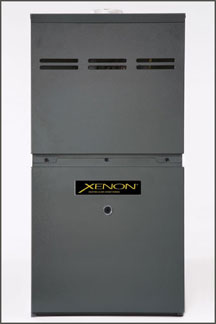What is a Furnace?
A traditional home-comfort system has two parts: an outdoor unit, such as an air conditioner or heat pump, and an indoor unit. The furnace is the indoor unit that heats and circulates warm air through your home in the winter, and in the summer, it takes the cool air from the outdoor unit and works as a fan to circulate it throughout your home. The indoor and outdoor units are designed to work together; and when the furnace is properly matched with a heat pump or air conditioner, the result is maximum efficiency and extended system life. Furnace heating ability is gauged with an Annual Fuel Utilization Efficiency (AFUE) percentage. A higher AFUE percentage indicates a more efficient furnace.
Variable-Speed Furnaces
Variable-speed furnaces circulate more air throughout the home for longer periods of time, reducing air stratification room-to-room and floor-to-floor. These longer run cycles can improve air quality by increasing air filtration. Variable-speed furnaces offer significant operating cost savings and whisper-quiet operation. XENON's variable-speed furnaces also feature an ECM blower motor that uses less electricity than a 100-watt light bulb. Standard furnace motors use nearly 500 watts.
Two-Stage Furnaces
These furnaces feature two-stage operation with electric hot surface ignition and an induced combustion system for quiet, efficient operation. Two-stage furnaces operate at low capacity during most of the operating cycle to maintain your level of comfort. On bitter cold days, the second stage is there to maintain comfortable temperatures.
Single-Stage Furnaces
Single-stage furnaces offer many new features not found on older furnaces. One feature is an inducer that draws the correct quantity of combustion air into the furnace for the most efficient operation possible. Another is an electronic ignition system that replaces the old wasteful pilot light. A third is a powerful, direct-drive blower that sends warmth to all the rooms in your home. These features will help make your home more comfortable, while reducing your heating fuel bills.
Oil Furnaces
Oil furnaces offer efficient heating, plus proven reliability, rugged construction, simple controls, and easy annual service. All units are built for long life and efficient operation.
The Basic Components of a Furnace System are:
- A Burner, through which gas (natural or propane) or oil is delivered and burned.
- A Heat Exchanger, where the heat produced from the burning gas is transferred to the air distribution system.
- Ductwork, to transfer the heated air throughout the home.
- A Flue or Vent Pipe, to exhaust byproducts of combustion (such as water vapor and carbon dioxide) to the outside.

©2014 Clockwork IP, LLC | All Rights Reserved.
